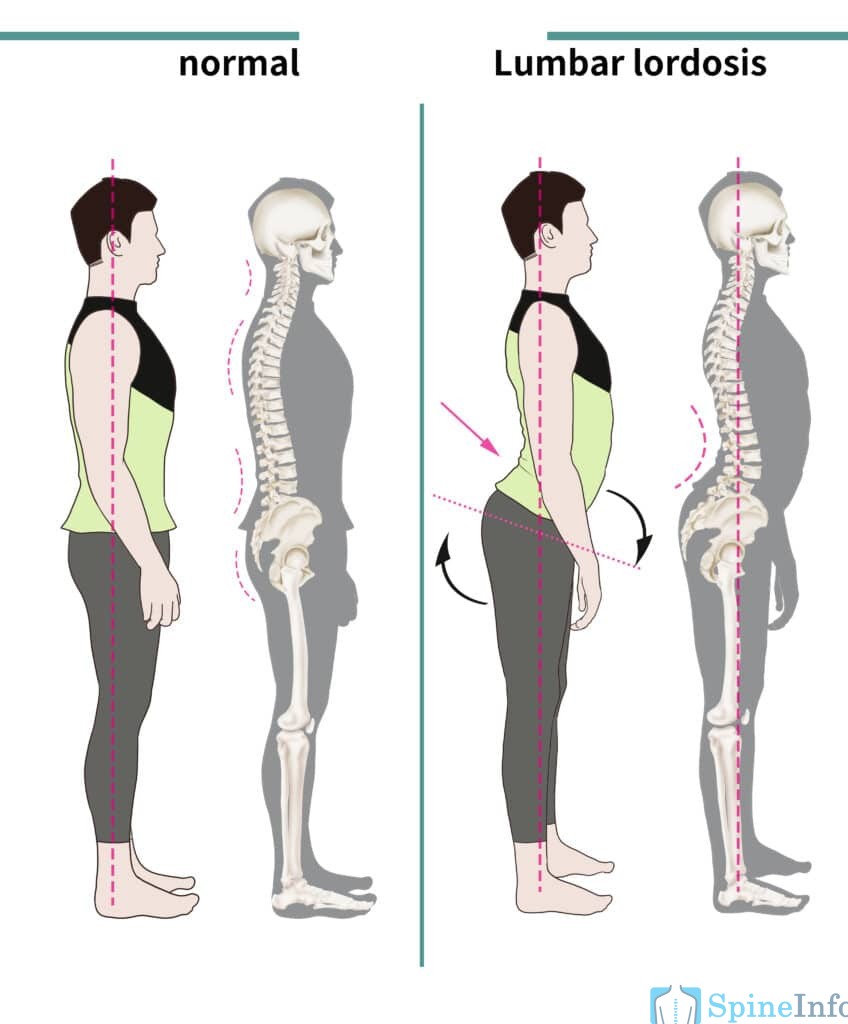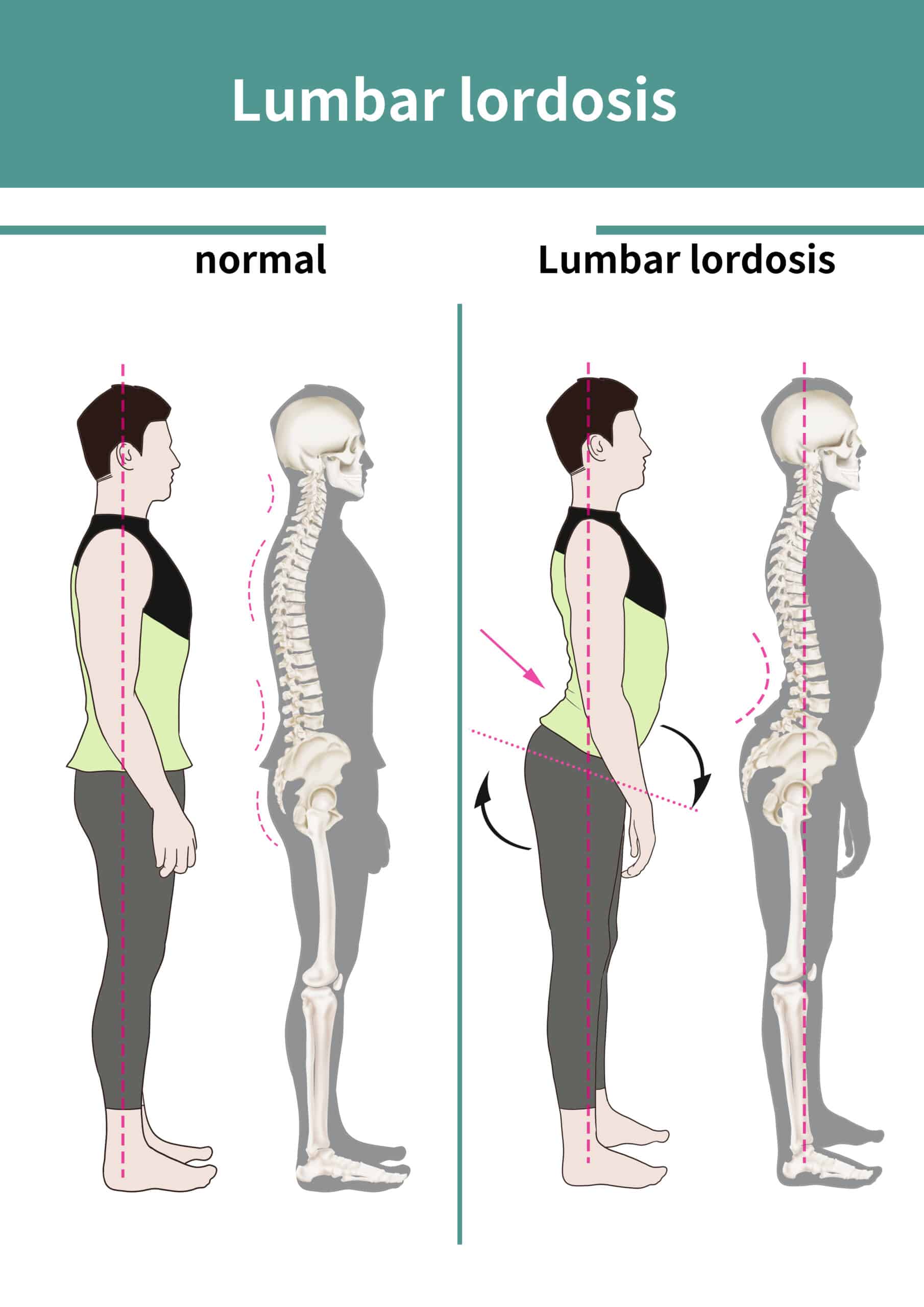Lordosis is the normal inward curvature of the spine in the lumbar region (lower back). Lordosis can become exaggerated, leading to a condition called hyperlordosis. Oftentimes, the term lordosis and hyperlodosis are used interchangeably. Hyperlordosis can cause pain and discomfort, as well as interfere with movement and balance. It may be caused by muscle imbalances, poor posture, or structural problems in the spine. Treatment for hyperlordosis may include exercises to strengthen the muscles in the back and abdomen, physical therapy, and changes in lifestyle and posture. In severe cases, surgery may be necessary to correct the curvature of the spine.

What is lordosis?
Lordosis is a term that refers to the normal inward curvature of the spine in the lumbar region (lower back). However, lordosis can become exaggerated, leading to a condition called hyperlordosis. This condition is also known as “swayback” or “anterior pelvic tilt.” Oftentimes, the term lordosis and hyperlodosis are used interchangeably.
What causes excessive lordosis?
There are several potential causes of hyperlordosis, including:
- Poor posture: Slouching or standing with poor posture can lead to hyperlordosis.
- Muscle imbalances: If the muscles in the front of the body (such as the hip flexors) are stronger than the muscles in the back (such as the muscles of the back and buttocks), this can cause hyperlordosis.
- Obesity: Excess weight can put additional strain on the lower back, leading to hyperlordosis.
- Pregnancy: The weight of the baby and the changes in the body’s center of gravity during pregnancy can cause hyperlordosis.
Prevalence of hyperlordosis
Hyperlordosis is relatively common, and it is estimated that up to 50% of the population may have some degree of lordosis.
Hyperlordosis is more common in women than in men, and it is also more common in people who are overweight or obese. It is also more common in people who have certain medical conditions, such as scoliosis or spondylolisthesis, and in people who have occupations that require prolonged standing or heavy lifting.
Symptoms of hyperlodosis
Many people with excessive lordosis do not experience any symptoms at all. However, some potential symptoms of hyperlordosis include:
- Back pain: Hyperlordosis can cause pain in the lower back, especially when standing or sitting for long periods of time.
- Difficulty moving or performing certain activities: Hyperlordosis can cause difficulty with movements that involve bending forward or backward, such as lifting or reaching.
- Visible curvature of the spine: In severe cases, hyperlordosis may be visible as an exaggerated curve in the lower back when standing or sitting.
- Fatigue: Hyperlordosis can cause fatigue, as the muscles in the back may have to work harder to support the spine.
It is important to note that not all people with hyperlordosis will experience symptoms, and the severity of symptoms can vary.
Diagnosis of hyperlodosis
Hyperlordosis is typically diagnosed through a combination of a physical examination and imaging tests.
History and Physical Examination
During a physical examination, your healthcare provider will look for signs of an exaggerated curvature in the lower back and may ask you to perform certain movements to assess your range of motion and flexibility.
Some physical exam findings that may be seen in lordosis include:
- Visible curvature of the spine: An excessive lordotic curve may be visible when the patient is standing or sitting.
- Pelvic tilt: Lordosis can cause the pelvis to tilt forward, which may be visible when the patient is standing.
- Difficulty with certain movements: Lordosis can cause difficulty with movements that involve bending forward or backward, such as lifting or reaching.
Imaging: X-ray
X-ray measurements are used to diagnose hyperlordosis by measuring the degree of curvature in the spine. There are several different measurements and angle calculations that a radiologist will make on the X-ray image to diagnose hyperlordosis.
Treatment of hyperlordosis
The treatment for lordosis will depend on the underlying cause of the condition and the severity of the curvature. Some common treatment options for lordosis may include:
- Physical therapy: Physical therapy or exercises for lumbar lordosis can help to improve posture, strengthen the muscles supporting the spine, and reduce pain. A physical therapist can teach the patient exercises to improve muscle balance and alignment, as well as provide manual therapy to address any muscle imbalances or tightness.
- Medications: Nonsteroidal anti-inflammatory drugs (NSAIDs) and other pain medications may be prescribed to manage pain and inflammation.
- Bracing: In some cases, a back brace may be recommended to help support the spine and improve posture. A lumbar lordosis brace, for example, is typically worn around the waist and can be adjusted to provide the appropriate amount of support and correct curvature of the spine.
- Surgery: In severe cases, surgery may be necessary to correct the curvature of the spine. There are several different surgical options available, including spinal fusion and spinal deformity correction surgery.
It is important to work with a healthcare provider to determine the most appropriate treatment for lordosis. The treatment plan may involve a combination of different therapies, and the patient may need to make lifestyle changes, such as losing weight or improving posture, to manage the condition.
Sources
Been E, Kalichman L. Lumbar lordosis. Spine J. 2014 Jan;14(1):87-97.
